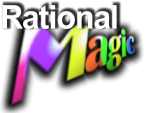

| Dragon Ball. Volume 1. By Akira Toriyama. Translated by Mari Morimoto. English adaptation by Gerard Jones. San Francisco, CA: Viz Communications, 1984, 2000. 175p. (Viz Graphic Novel). $14.95. ISBN 1-56931-495-0. |

|
GENRES: AUDIENCE: NOTE: This book collects issues #1-6 of Dragon Ball. ANOTHER NOTE: This is book #1 in a series of 42! SYNOPSIS: After Goku rescues a talking turtle from being eaten and taking it back to the sea, an old hermit (Kame Sen'nin, the Turtle Hermit) gives him a magic flying cloud, Kinto'un, on which he zips around through the sky. (The hermit also has a Dragon Ball that he gives Bulma after she lets him peek at her panties.) Goku uses the cloud to good advantage when he saves a village from a shapeshifter, Oolong, who's been making off with their girls. Oolong turns out to be a surly piglet who becomes a most reluctant member of this increasingly motley adventuring group; Bulma keeps him in line by secretly feeding him a "Swee-Trot" candy that gives Oolong the runs if she whistles "Swee." After Bulma loses her hoipoi capsules and the trio is forced to walk through the desert, they begin a series of encounters with Lord Yamcha, a handsome young desert bandit, and his faithful sidekick, the shapeshifting Pu'ar. A superior fighter who even bests Goku at one point, he goes to pieces at the mere sight of Bulma, which abruptly stops most of the fights he picks with Goku. When he learns about the Dragon Balls, Yamcha determines to get the balls for himself and wish that girls didn't scare him so much. Unable to take them directly, however, he gives the group a hoipoi capsule with a little car by way of "apology," and he and Pu'ar follow at a distance. Having already retrieved five balls, Bulma is feeling very confident, but she's less so when the sixth ball turns up in the possession of the dreadful Ox King..... The book includes a title page gallery for the ten chapters that appeared in the original six issues). EVALUATION: Anyway, this is where it all began, and I'm pleased to report that it's an excellent book, loaded with well-realized farce and absurd humor. The sketchy synopsis above doesn't begin to cover the many little moments in the dialogue and art that mark Dragon Ball as a superior humor title: Goku's innocent and frank appraisal of all the women he encounters, and his horror when he discovers that Bulma doesn't have balls (a discovery he makes by checking her out while she's asleep); Bulma's insistence that she is a sexy chick, and her frustration when the only ones who show interest in her are the least desirable males in the book (who mostly have fetishes about her panties); the excellent conceits of the hoipoi capsules, Yamcha, swee-trots, and the "dueling shapeshifters"; the annoyed interchange between Bulma and the father of a potential kidnapee in the village that Oolong was terrorizing ("You know, if we had more time I could really dislike you," the father tells Bulma); the absolutely perfect freeze take Yamcha does when he sees Bulma for the first time; the inept transformations of both Oolong and Pu'ar when one becomes Bulma and the other Goku; Bulma being forced to wear a Playboy Bunny outfit because it's the only thing in her size that Oolong has; and much, much more. Toriyama has one of the most slapstick manga styles I've ever seen, and one of the cleanest; he's a premiere humor artist, on a par with Phil Foglio or Evan Dorkin or any of the classic artists from Mad. His style is supremely economical; he doesn't waste a line or a panel. His fight scenes are beautiful: you can follow them, which is a rare thing indeed in the world of manga, and they're also short; most of this book is plot- and character-driven, not combat-driven, hooray! Toriyama could teach a class on facial expressions and body language as well; both are so expressive that I think one could follow the story in this book even if it hadn't been translated.
I have two quibbles with this book. First, to preserve the original order of the panels, Viz chose to make this a right-to-left book. (Bringing Home the Sushi does this too.) I suppose this gives one the sense of the original comic "as nature intended," but it's very hard for this Westerner (and probably others) to consistently read in that direction. (I suppose if I'd learned to read Hebrew... but I didn't.) My eyes keep jumping to the left-hand panels, which occasionally spoiled a visual punchline because I read it too soon. Even on subsequent readings I had this trouble, suggesting that our left-to-right convention is way too ingrained to shed so quickly. Viz also put the cover on the back of the book, which will probably irk librarians. My second quibble is that according to Chris Butcher of PopImage, the artwork was "cleaned up" slightly for American consumption. I'm not sure what--probably little cartoon nipples and some crotch shots. I can understand why (and appreciate the cleaned-up version for libraries and comic book stores that don't need controversy from unexpected directions), but the issue underscores the differences in sexual acceptance between the two cultures, and not everyone who reads this title is going to be a kid. I wish Viz had created two versions: a kid-friendly one and the original, unaltered "adult" one (which is presumably available in an untranslated version). Nevertheless, this is an absolutely first-rate title and will be enjoyed by readers of all ages. It would be an excellent book for reluctant readers as well, assuming they don't balk at the right-to-left format. Part of a core collection of manga--though anyone who can afford all 42 books (assuming they're all translated) is doing very well indeed! And it's essential for fans of the series. |
Return to Rational Magic Home
